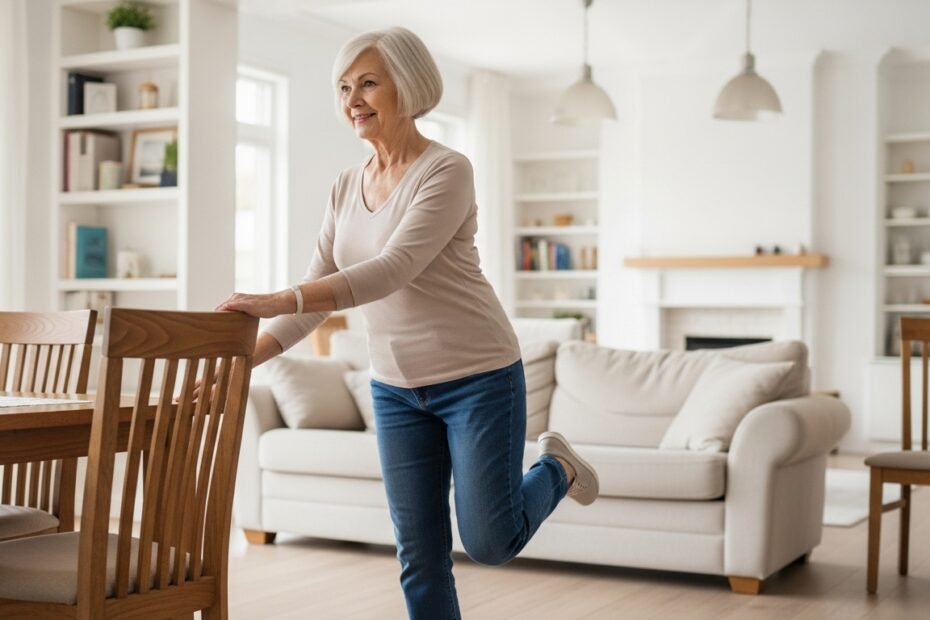Feeling unsteady on your feet can be a frightening experience, impacting your confidence and limiting your activities. While balance issues are more common in older adults, they are not something you simply have to accept. The good news is that with targeted effort and the right strategies, you can significantly improve your stability and regain your sense of balance.[1]
Regaining balance is a multi-faceted process that involves strengthening your body, understanding underlying causes, and making smart lifestyle choices. This comprehensive guide will walk you through the most effective ways to rebuild your stability and prevent falls.
Why Does Balance Decline with Age?
Several factors can contribute to a loss of balance in seniors:
- Muscle Weakness: Age-related muscle loss (sarcopenia), especially in the legs and core, is a primary culprit.[2] Strong muscles are essential for holding you steady and reacting quickly to a stumble.
- Inner Ear Issues: The vestibular system in your inner ear is your body’s personal gyroscope.[2] Age or certain conditions like labyrinthitis can disrupt this system, causing dizziness and a feeling of being off-balance.[3]
- Medication Side Effects: Many common medications for conditions like high blood pressure, depression, and pain can cause dizziness or drowsiness, directly impacting balance.[4]
- Vision Changes: Poor eyesight makes it harder to spot hazards and navigate your environment safely.
- Chronic Conditions: Health issues like arthritis, diabetes (which can cause nerve damage in the feet), and Parkinson’s disease can all affect your mobility and stability.[4]
The Foundation: Exercises to Rebuild Balance and Strength
Physical activity is the single most effective tool for regaining balance.[5] The goal is to strengthen key muscles and retrain your body’s ability to maintain its equilibrium. Always consult your doctor before starting a new exercise routine. For safety, perform these exercises near a wall or a sturdy chair you can hold onto for support.
1. Single-Leg Stand:
This is a fundamental balance builder.
- Stand behind a sturdy chair, holding on for support.
- Lift your right foot off the floor, bending the knee.
- Hold the position for 10 seconds, working your way up to 30 seconds.[6]
- Lower your foot and repeat with the left leg. Aim for 3-5 repetitions on each side.[7][8]
2. Heel-to-Toe Walk:
This exercise improves coordination and simulates walking on an uneven surface.
- Stand tall and place the heel of your right foot directly in front of the toes of your left foot, as if walking on a tightrope.[9]
- Step forward, placing your left heel in front of your right toes.
- Continue for 15-20 steps. Use a wall for support if needed.[9][10]
3. Sit-to-Stands:
This crucial exercise builds leg and glute strength, making it easier to get up from any chair.[11]
- Sit in a sturdy, armless chair with your feet flat on the floor, hip-width apart.
- Leaning your chest slightly forward, squeeze your glutes and push through your heels to rise to a full standing position.[8]
- Slowly lower yourself back down with control.
- Repeat 10-15 times.[8]
4. Tai Chi:
This gentle, low-impact martial art involves slow, flowing movements that are excellent for improving balance, flexibility, and stability.[6][12] Many senior centers and community gyms offer beginner Tai Chi classes.
Lifestyle Adjustments for Lasting Stability
Beyond exercise, simple changes can make a world of difference:
- Medication Review: Ask your doctor or pharmacist to review all of your medications—including over-the-counter drugs and supplements—to see if any could be affecting your balance.[12]
- Get Your Vision and Hearing Checked: Annual eye exams are essential.[13] Since inner ear issues are a common cause of balance problems, report any hearing changes or feelings of dizziness to your doctor.[1]
- Wear Proper Footwear: Ditch the backless slippers and worn-out shoes. Opt for sturdy, well-fitting shoes with non-slip soles that provide good support.[13]
- Stay Hydrated and Eat Well: Dehydration can cause dizziness and weakness.[14] A balanced diet rich in calcium and other minerals helps maintain strong bones and muscles.[15]
When to Seek Professional Help
If you experience a sudden loss of balance, persistent dizziness, or have a fall, it is crucial to see your doctor. They can rule out underlying medical conditions.[1]
A physician may refer you to a physical therapist, who are experts in movement and balance.[16] A physical therapist can conduct a fall risk assessment and design a personalized exercise program to address your specific weaknesses, significantly improving your strength, coordination, and confidence.[17][18]
Regaining your balance is an achievable goal. By incorporating these exercises and lifestyle tips, you can build a stronger, more stable foundation for a safe and active life.
Join Us on Youtube – Senior Recuperate
